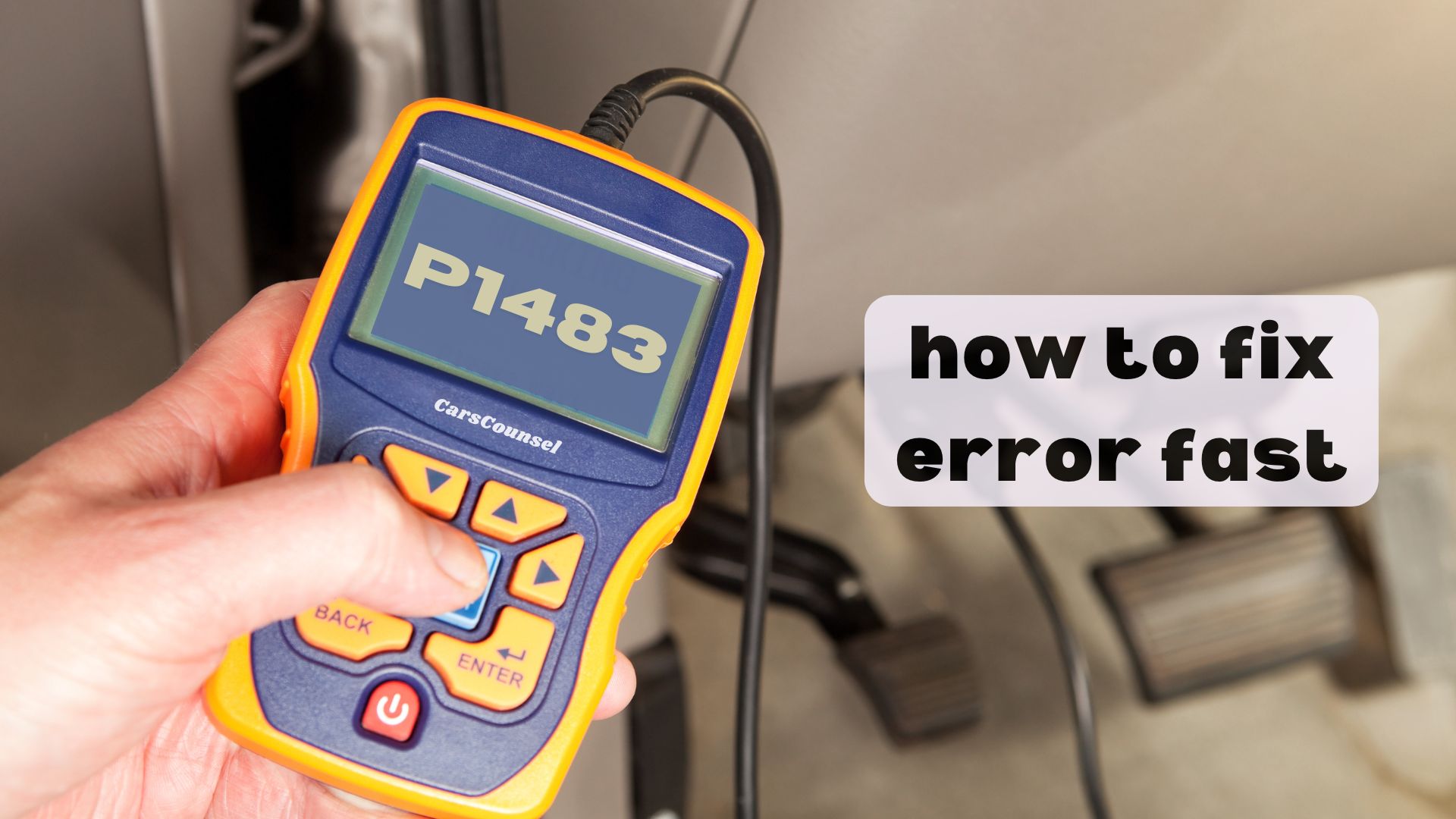As you’re driving, you notice your temperature gauge rising, accompanied by an unsettling engine noise. The check engine light comes on, and you’re left wondering what’s going on. A quick scan reveals the P1483 code, indicating a problem with your engine cooling system performance. This can lead to overheating, decreased performance, and potential engine damage if left unaddressed. You’re likely wondering what’s causing this issue and how to fix it – let’s plunge into the specifics to get your engine running smoothly again.

Quick Navigation
Key Takeaways
- The P1483 code indicates a problem with engine cooling system performance, leading to overheating and potential engine damage.
- Common causes include low coolant levels, radiator damage, faulty thermostats, and water pump failure.
- Ignoring the issue can lead to severe engine damage, decreased performance, and compromised cooling system performance metrics.
- Regular maintenance, such as checking for coolant leaks and inspecting the thermostat, can help prevent engine cooling system performance issues.
- Prompt diagnosis and repair are essential to prevent severe engine damage and maintain optimal engine performance.
P1483 Code Description
When your car’s onboard computer triggers the P1483 code, it’s a warning sign that your engine cooling system is malfunctioning.
This error code indicates a problem with the performance of your engine’s cooling system, which can lead to overheating and potential damage to engine components. As a result, you may notice a decrease in performance and efficiency.
P1483 code warnings signal cooling system failures, leading to overheating, engine damage, and decreased performance and efficiency.
To diagnose the issue, you’ll need to inspect the cooling system, including the coolant level, thermostat, radiator, water pump, and other components.
Proper engine diagnosis is vital to identify the root cause of the problem and prevent more severe damage to your engine.
Common Causes of P1483 Code
Since your engine’s cooling system isn’t performing as it should, you’ll need to identify the root cause of the problem.
A low coolant level, often due to coolant leaks, is a common culprit. Radiator damage, clogging, or malfunction can also trigger the P1483 code.
Other possible causes include a faulty thermostat, water pump failure, or other cooling system component failures.
It’s essential to inspect the entire system to determine the source of the issue. By doing so, you’ll be able to address the problem and prevent further engine damage.
Repair Importance and Difficulty
The P1483 code repair importance level is rated 3 (High) due to the potential damage to your engine if left unaddressed.
This rating is justified, as neglecting the issue can lead to severe engine damage, decreased performance, and compromised cooling system performance metrics.
You’ll need to prioritize the repair to prevent further complications.
The repair difficulty level is also rated 3 (Hard), indicating that you may require professional assistance to diagnose and fix the underlying cause.
Be prepared to invest time and resources to get your cooling system back on track.
Engine Cooling System Performance Issues
You’re dealing with engine cooling system performance issues, which can have devastating consequences if left unchecked.
Ignoring these problems can lead to engine damage, decreased performance, and reduced fuel efficiency. To avoid these issues, it’s essential to identify and address the root cause of the problem.
Don’t let neglected engine cooling issues lead to costly damage, poor performance, and wasted fuel – identify and fix the root cause.
- Check for coolant leaks, which can cause the engine to overheat and lead to costly repairs.
- Perform regular radiator maintenance to guarantee proper coolant circulation and heat dissipation.
- Inspect the thermostat for proper operation, as a malfunctioning thermostat can cause the engine to overheat or underheat.
- Look for signs of corrosion or damage to the cooling system components, which can lead to premature failure.
Symptoms of P1483 Code
When your car’s onboard computer triggers the P1483 code, it’s a red flag indicating a problem with the engine cooling system performance.
You may notice symptoms like overheating, coolant leaks, or unusual engine noises. The temperature gauge may rise, and you might see steam or coolant leaking from the radiator or hoses.
Engine noises like knocking, clunking, or grinding sounds can also indicate a problem. If you ignore these symptoms, you risk severe engine damage, so it’s essential to address the issue promptly.
Be prepared to investigate further to identify the root cause of the problem.
Diagnosing the Problem
Diagnosing the problem behind the P1483 code requires a systematic approach to identify the faulty component or malfunctioning system.
You’ll need to use diagnostic tools to inspect the cooling system, checking for signs of overheating, leaks, or blockages.
- Inspect the coolant level and condition, looking for signs of contamination or degradation.
- Use a scan tool to monitor engine temperature and coolant system performance.
- Perform a pressure test to identify leaks or blockages in the system.
- Visually inspect the thermostat, radiator, and water pump for signs of malfunction or failure.
Repair Estimate and Cost
The cost of repairing the engine cooling system performance issue behind the P1483 code can vary widely, depending on the specific cause and extent of the problem.
You’ll need to set a repair budget, considering the cost breakdown of parts and labor. On average, you can expect to pay between $200 and $600, but this range can fluctuate depending on the complexity of the repairs.
A faulty thermostat might be a relatively inexpensive fix, while a faulty water pump or radiator replacement can be more costly.
Get an accurate estimate from a professional mechanic to plan your repair budget effectively.
Fixing the Engine Cooling System
You’ll need to take a systematic approach to fix the engine cooling system, addressing each potential cause of the P1483 code to guarantee a thorough repair.
Start by checking the coolant level and condition, then inspect the thermostat and cooling components for proper operation.
Next, perform a Coolant Flush to remove any debris or contaminants that may be affecting the system’s performance.
- Inspect the radiator for blockages or damage
- Check the water pump for signs of failure
- Test the thermostat to certify it’s opening and closing correctly
- Verify the cooling system’s electrical connections are secure and functioning properly
Preventing Future Issues
To prevent future issues with your engine cooling system, make sure to regularly check the coolant level and condition, guaranteeing it’s at the recommended level and free from contamination.
You should also inspect the thermostat, radiator, and water pump for proper operation. Regular inspections will help identify potential problems before they become major issues.
Implement a Cooling System Maintenance routine to extend the life of your engine and prevent costly repairs. By staying on top of maintenance, you’ll avoid overheating, decrease performance issues, and certify your engine runs smoothly and efficiently.
Next Steps and Recommendations
Now that you’ve taken proactive steps to prevent future issues with your engine cooling system, it’s time to address the current problem at hand.
To resolve the P1483 code, you’ll need to perform a thorough performance check on your cooling system.
- Check the coolant level and condition to verify it’s at the recommended level and free of contaminants.
- Inspect the thermostat and cooling components for proper operation and signs of wear.
- Run a series of tests to identify the root cause of the issue, including a pressure test and a leak-down test.
- Based on the test results, replace any faulty components and perform any necessary repairs to get your engine running smoothly again.
More OBD-II Codes
| P1484 | P1485 | P1486 | P1291 |
| P1292 | P1293 | P1294 | P1226 |
| P1209 | P1210 | P1204 | P1202 |
| P1203 | P1198 | P1146 | P1145 |
| P1144 | P1143 | P1142 | P1140 |
| P1139 | P1141 | P1138 | P1137 |
Frequently Asked Questions
Can a Faulty Temperature Sensor Cause a P1483 Code?
You’re wondering if a faulty temperature sensor can trigger a code. Yes, it can. Sensor failure modes, such as temperature fluctuation, can mislead the engine computer, causing incorrect cooling system performance readings, which may result in a P1483 code being thrown.
Will a P1483 Code Trigger the Check Engine Light?
Did you know that 60% of engine failures are caused by cooling system issues? You’re right to wonder, will a P1483 code trigger the check engine light? Yes, it will, especially if you’re experiencing coolant leaks or engine overheating, which can lead to severe engine damage if left unchecked.
Can I Drive My Car With a P1483 Code?
When dealing with engine performance issues, you shouldn’t drive your car excessively, as it may cause further damage. Limit driving to safe distances and avoid heavy loads to prevent overheating, but prioritize repairs to avoid catastrophic engine failure.
How Long Does It Take to Fix a P1483 Code?
You’ll typically spend 1-3 hours diagnosing the cooling system issue, and 2-6 hours repairing or replacing the faulty component, depending on the complexity of the engine diagnosis and the extent of the repairs needed.
Will a P1483 Code Affect My Car’s Fuel Efficiency?
Imagine a marathon runner with a fever – their performance plummets. In like manner, when your engine’s cooling system malfunctions, it impacts engine performance, causing your car to guzzle fuel, decreasing fuel efficiency. A faulty cooling system can decrease engine performance by up to 20%, directly affecting your gas mileage.
Conclusion
As you navigate the complexities of your engine’s cooling system, recall that a P1483 code is a ticking time bomb, waiting to release a wave of destruction on your engine’s essential components. Don’t let ignorance be your downfall – tackle the issue head-on, and breathe new life into your engine. With the right repairs, your cooling system will hum like a well-oiled machine, and your engine will purr like a contented beast. The clock is ticking – take control of your engine’s fate today.

